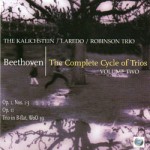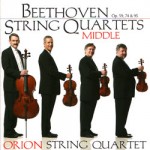Column Name
Title
In his perceptive notes to the Orion String Quartet’s new release of the Beethoven middle quartets, Daniel Felsenfeld recalls a comment from Elliott Carter about quartet personnel rehearsing more often, ensuring more frequent performances, and thus encouraging composers to invest the genre with their most intimate thoughts. Beethoven was one composer whose chamber works reflect his deep, innermost world. Here, in three recent releases, his thoughts encompass unexpected contrasts, by turns violent and lyrical, austere and sensual, and often infused with a certain playfulness.
Body
Belgian cellist Nicolas Deletaille, who earned a master’s degree from Juilliard in 2003 (studying, coincidentally, with Timothy Eddy, cellist for the Orion Quartet, whose recording is reviewed below), has teamed up with pianist Jean-Michel Dayez in an appealing new two-disc set of Beethoven’s five Sonatas for Piano and Cello (recorded in the Columban Hall in Wavre, Belgium, on the Contréclisse label). Engineered by Luc Henrion, the recording is closely miked, with Deletaille’s rustling chair occasionally audible, but the payoff is magnified intensity and presence, as if he and Dayez are at arm’s length, right in the middle of the listener’s living room. Deletaille isn’t afraid to add a slight gruffness as he digs in to the sinews of the Op. 5, No. 1, in contrast to his pianist’s sparkling finger work. Yet when the composer mutes his high spirits Deletaille can drop down to a hush. The duo brings more desolation to the two late Op. 102 sonatas, which are brimming with increased wisdom and harmonic sophistication. More concise than the other three, these are less sprightly—more concentrated and volcanic—and Deletaille and Dayez show admirable focus in attacking the often-brutal mood changes.
Marking its 30th anniversary, the Kalichstein-Laredo-Robinson Trio opens this re-release (on Koch) with a vivacious account of the Piano Trio, Op. 1, No. 2. These three renowned players revel in the composer’s gentleness and thunderbolts, and capture the opening drama perfectly. Pianist and Juilliard faculty member Joseph Kalichstein (who holds the Edwin S. and Nancy A. Marks Chair in Chamber Music Studies) is given the lion’s share of notes to manage, yet has an uncanny ability to articulate with the greatest delicacy, with the sweetness of Jaime Laredo’s violin adding intimacy. And despite cellist Sharon Robinson’s huge sound, the balance remains realistic, thanks to wizard engineer Adam Abeshouse. The pensive largo is as somber as the first movement is extroverted, and when the final presto arrives, the music crackles with the three musicians in blistering synchronicity. Some may wish for a bit more relaxation here, but I found the tempo akin to a huge oxygen rush. In the third Piano Trio in C Minor, similar ferocity gives the prestissimo finale a bracing energy. Disc two is equally precise and satisfying, with the ensemble glittering in the Piano Trio in E-flat (Op. 1, No. 1), the Trio in B-flat (Op. 11, with its pensive adagio gorgeously done here) and the single movement Trio in B-flat, WoO 39.
Also on Koch (and again with the Abeshouse magic touch), the Orion String Quartet brings a lively approach to the five middle Beethoven quartets. Juilliard alumnus Daniel Phillips leads the group with poise and elegance in the F Major (Op. 59, No. 1), which occasionally explodes in the best way. Juilliard faculty member Timothy Eddy is the agile cellist, in a group that seems to relish Beethoven’s roller-coaster-ride qualities, and knows how to exploit the composer’s occasional chuckle for maximum effect. Alternating with his brother in the first violin role, Todd Phillips (also a Juilliard alum) elicits a bravura performance of the C Major (Op. 59, No. 3) with its startlingly weird opening sequence, and in the final movement, violist Steven Tenenbom leads the ferocious fugue, dispatched at a hair-raising tempo. The famous “Harp” Quartet (Op. 74) sings like its nickname, at least when the Orion players aren’t showing off the work’s precocity. Freshness courses through the entire set—a quality all three of these recordings share—and only increases anticipation for the completion of the entire cycle.







